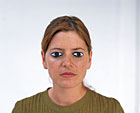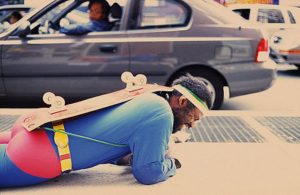The funny thing about the Whitney Biennial is that it operates as if everyone had amnesia. Every two years it exhibits what it describes as “the most important recent work made by American artists.” Usually about a hundred artists are selected. It’s an honor. Whitney Biennials launched the careers of such artists as Edward Hopper, Georgia O’Keeffe, and Milton Avery.

Karin Campbell in “When I Close My Eyes.”
The problem nowadays is that every Biennial brings forth a whole new batch. You have to wonder, what happened to the ones from two years ago? They don’t even make the cut anymore? And that new style that was all the rage– neoconceptualist-appropriationism, or whatever —is likewise a thing of the past, or at least fading fast?
Everyone’s gotten used to this, so it’s hardly mentioned anymore. Everyone recognizes that the Biennial is basically a big fashion show – fickle, full of hype, and prone to shallow shock tactics. The only difference is that in fashion, as in every other field of art and entertainment, there are rules, and also stars who rise or fall from year to year based on the creative risks they take.
But the Biennial is more of an ensemble production, with a new cast every two years. Quick, name your five favorite contemporary American artists, people whose careers you follow with interest, as with a favorite writer, actor, director, or singer. Can’t think of any?
It’s an odd situation. Of course, the art world has always been insular, a small town of artists, curators, dealers, collectors, critics, and art historians. The public doesn’t play much of a part, as it does in literature or film or drama. No Biennial has ever bombed and been forced to close prematurely.
So there really is no such thing as a good Biennial or a bad one, or if there is, there’s no point in saying it, because that’s not what this game is about. The purpose of the Biennial is to tell you that, once again, art has changed. It is not what you thought it was. It has not just changed its content, as do films, books, and drama from year to year. Nor is it simply a matter of changing style, as from, say, realism to expressionism in painting. The changes are more like redefinitions of art.
This tends to make the Biennials sort of critic-proof as well. New things tend to be exempt from criticism, because the aesthetic standards don’t exist yet.
Take, for example, something from the current Biennial, “A Visit With Joseph Cornell,” by two Los Angeles “sound artists” who call themselves Archive. Their art form consists of interviewing deceased artists through seances conducted by professional psychics. Their Biennial artwork is a 10-minute CD based on four of these posthumous interviews that were held at the museum.
Not to complain, but it’s hard to know where to start with something like this. What exactly is it? Since it’s all words, it might fit into some literary category. Or maybe it’s theater. Or a comedy routine. But art? And what about the seance part of it, the alleged spiritualism?
If you put these questions to the artists, they would answer that the questions themselves are the point, that they are engaging issues of interpretation, art history, identity, storytelling, etc., etc. In other words, they themselves are critics, of a sort. Even critics of criticism. Try criticizing that, and you’re into a Calvin and Hobbes routine.
If a lot more artists started talking to the dead, then some critical standards might evolve. You could compare them. Probably there are good seances and bad seances. But the Whitney is too quick on its feet for that. Because novelty, not quality, is what the Biennial is peddling.
Barring some obscenity scandal or censorship controversy that needs explicating, there really is only one critical approach to the Biennial, and that is to ask what’s new this time around? How’s it different from two years ago? And then get busy with the taxonomy, the classifying and naming of these exotic artistic variations, hybrids, and mutants.
So let’s get down to it. This year the buzzwords are performance art, Internet art, installation art, and sound art.
Hmm. First, be suspicious of all art that requires the word “art” in its name. (We don’t say “painting art,” or “sculpture art.”) Consider performance artist Karin Campbell, whose performance art consists of sitting in a gallery with her eyes closed, talking to people. And, oh yeah, she has large cartoonish eyes painted on her closed eyelids. People, of course, want to know why she’s doing that, but by asking and talking to her, they’re falling into her artist trap and becoming part of the performance artwork themselves.

William Pope.L crawling up Broadway in a performance piece for the Whitney Biennial
Another performance artist is William Pope.L (whose middle initial seems to have migrated to the end of his name, and gotten in front of the period). He plans to don a Superman costume, strap a skateboard to his back, and crawl on his belly like a reptile the entire length of Manhattan Island – all 22 miles. Critics—don’t even think about it. Photographers —form a line! Pope.L plans to take a lot of time off during this crawl, with an estimated arrival time at the top of Broadway sometime in 2007. Nice try, Pope.L, but there’s no way you’re going to be in the next two Biennials with that tired act.
Then there are the couple who call themselves Praxis (collaboratives, a vestige of the Sixties, is another buzzword of the 2002 Biennial). Once a week, either at the museum or their East Village studio, they will offer foot washes, hugs, Band-Aid applications (no wound required), and gifts of one-dollar bills (no repeat customers). Notice that it is no longer necessary to actually be in the museum to be in the Biennial. Five of the artworks, in fact, are in Central Park, including a 50-foot-tall steel tree (completely disease-resistant) and a splash-producing device in a pond that tricks passers-by into thinking that something just fell from the sky.
Installation art isn’t new to this Biennial, but this year’s models have more moving parts and more noisemaking capacity. Installation art used to consist of very quiet things, like rooms full of dirt. Now, every other installation has a TV in it, or mechanical arms, or, at the very least, a sound system, making this a very noisy Biennial of murmuring , electronic whirrs and clicks, howling winds, and creepy robotic voices.
Internet and computer art remain hopelessly boring and hard to understand. In a show where the inexplicable is commonplace, the Whitney has felt the need to provide docents at these stations. Their job is to try to explain why, for example, one artist used data visualization software to transform the 200,000-word text of Mark Twain’s “Innocents Abroad” into a dynamic spherical web of lines and words.
But by far the most stunning innovation at this year’s Biennial is the addition of “sound art.” You feel your way into pitch-black galleries and then you listen as weird and scary sounds whirl around you. Nothing to look at at all. It takes real courage for a visual arts museum to mount exhibits that have absolutely no visual content.
Of course, by now there should be no mystery as to why there are so few repeats at Whitney Biennials and absolutely no stars. The artists can’t keep up. Oh, you’re still making visible art? Sorry, this isn’t your year. Then again, there’s something sort of democratic about it, everyone getting their 15 minutes of fame and all, not to mention the even more democratic, anti-elitist conviction that there is no idea too vague or convoluted, no object or non-object, nothing in fact, that can’t be considered art.

